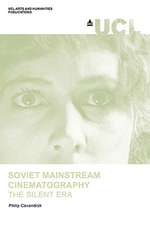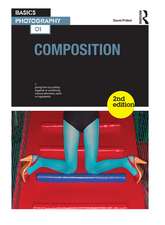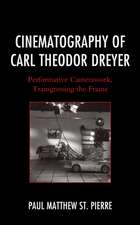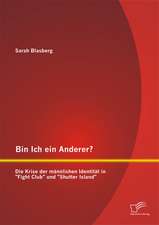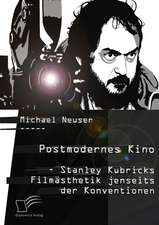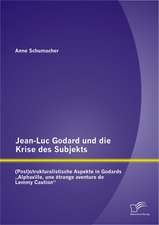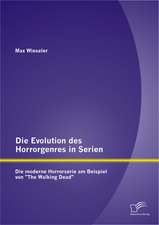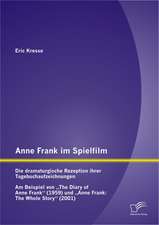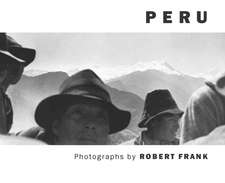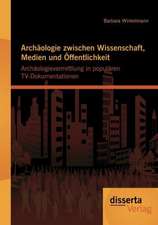Cinematography in the Weimar Republic: Lola Lola, Dirty Singles, and the Men Who Shot Them: The Fairleigh Dickinson University Press Series in Communication Studies
Autor Paul Matthew St. Pierreen Limba Engleză Hardback – 12 aug 2016
Din seria The Fairleigh Dickinson University Press Series in Communication Studies
- 23%
 Preț: 663.14 lei
Preț: 663.14 lei - 27%
 Preț: 710.87 lei
Preț: 710.87 lei -
 Preț: 461.87 lei
Preț: 461.87 lei - 27%
 Preț: 739.20 lei
Preț: 739.20 lei -
 Preț: 436.34 lei
Preț: 436.34 lei -
 Preț: 505.96 lei
Preț: 505.96 lei - 27%
 Preț: 684.65 lei
Preț: 684.65 lei - 23%
 Preț: 591.98 lei
Preț: 591.98 lei -
 Preț: 446.65 lei
Preț: 446.65 lei - 27%
 Preț: 679.73 lei
Preț: 679.73 lei - 23%
 Preț: 662.38 lei
Preț: 662.38 lei - 23%
 Preț: 702.15 lei
Preț: 702.15 lei - 23%
 Preț: 490.94 lei
Preț: 490.94 lei - 23%
 Preț: 685.09 lei
Preț: 685.09 lei -
 Preț: 451.44 lei
Preț: 451.44 lei - 27%
 Preț: 818.13 lei
Preț: 818.13 lei -
 Preț: 386.17 lei
Preț: 386.17 lei -
 Preț: 397.67 lei
Preț: 397.67 lei - 23%
 Preț: 648.64 lei
Preț: 648.64 lei - 23%
 Preț: 649.09 lei
Preț: 649.09 lei - 23%
 Preț: 648.50 lei
Preț: 648.50 lei -
 Preț: 534.51 lei
Preț: 534.51 lei - 23%
 Preț: 455.62 lei
Preț: 455.62 lei -
 Preț: 413.57 lei
Preț: 413.57 lei -
 Preț: 443.72 lei
Preț: 443.72 lei - 22%
 Preț: 271.44 lei
Preț: 271.44 lei
Preț: 718.02 lei
Preț vechi: 983.60 lei
-27% Nou
Puncte Express: 1077
Preț estimativ în valută:
137.39€ • 143.74$ • 114.13£
137.39€ • 143.74$ • 114.13£
Carte tipărită la comandă
Livrare economică 03-17 aprilie
Preluare comenzi: 021 569.72.76
Specificații
ISBN-13: 9781611479447
ISBN-10: 1611479444
Pagini: 286
Dimensiuni: 160 x 236 x 28 mm
Greutate: 0.62 kg
Editura: Rowman & Littlefield
Seria The Fairleigh Dickinson University Press Series in Communication Studies
ISBN-10: 1611479444
Pagini: 286
Dimensiuni: 160 x 236 x 28 mm
Greutate: 0.62 kg
Editura: Rowman & Littlefield
Seria The Fairleigh Dickinson University Press Series in Communication Studies
Notă biografică
By Paul Matthew St. Pierre
Cuprins
List of Illustrations
Acknowledgments
1 The Weimar Revolution and German Collaborative Filmmaking
2 The Optical Convergence of Theodor Sparkuhl and Ernst Lubitsch
3 Karl Freund¿s Signature Visual Designs in Manifold Collaborations
4 Carl Hoffmann and the New Visual Discourse of German Silent Film
5 Fritz Arno Wagner, with F. W. Murnau, Fritz Lang, and Arthur Robison
6 Fritz Arno Wagner, G. W. Pabst, and the Weimar Zeitgeist
7 Günther Rittau, Günther Krampf, Optical Language, and Autonomous Collaborative Agency
8 Guido Seeber¿s Promotion from Special Effects Technician to Cinematographic Artist
9 Rudolph Maté, Carl Theodor Dreyer, and the Framing Principle of Cinematography
10 Cinematographers as Directors as Cinematographers and the Rebirth of Civilization
Filmography
Works Cited
Index
About the Author



